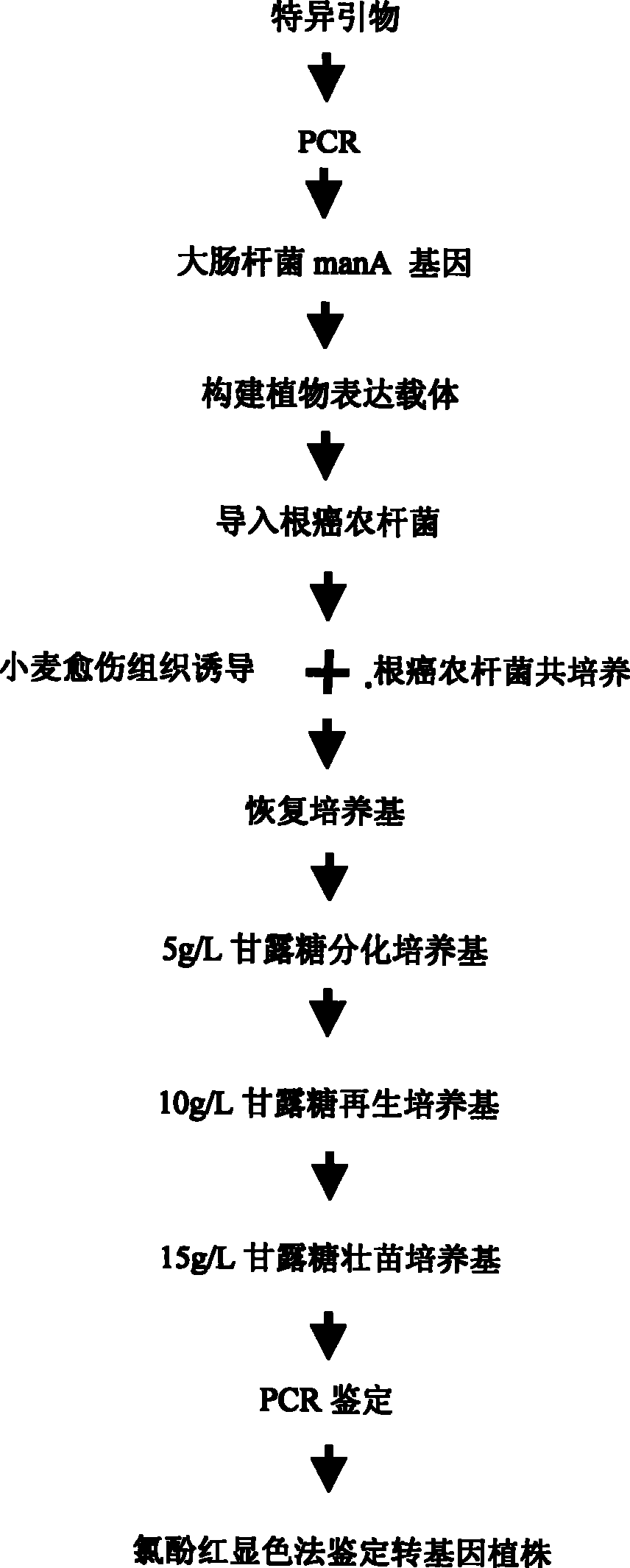Non-antibiotic method for sifting wheat transgenic plant
A non-antibiotic screening and transgenic plant technology, applied in the field of plant transgenic technology, can solve problems such as herbicides cannot be killed, pathogenic bacteria develop drug resistance, and ecological imbalance
- Summary
- Abstract
- Description
- Claims
- Application Information
AI Technical Summary
Problems solved by technology
Method used
Image
Examples
Embodiment 1
[0078] Callus Induction of Wheat Varieties
[0079] The young ears of the wheat variety Zheng 9023 (this variety comes from the Henan Academy of Agricultural Sciences) at the floret primordia formation stage were induced to callus under the following conditions: at the floret primordium formation stage, the young ears of wheat were taken after being disinfected with alcohol Strip the young ear, select the young ear with a length of 1 cm and cut it into about 1 mm, and place it on the L7 medium to induce callus (the composition of the L7 medium: 250 mg / L NH 4 NO 3 , 1500mg / L KNO 3 , 200mg / L KH 2 PO 4 , 350mg / L MgSO 4 ·7H 2 O, 450mg / L CaCl 2 2H 2 O, 11.61mg / L MnSO 44H 2 O, 5mg / L H 3 B O 3, 7.5mg / LZnSO 4 ·7H 2 O, 0.75mg / L KI, 0.25mg / L Na 2 MoO 4 2H 2 O, 0.025mg / L CuSO 4 ·5H 2 O, 0.025mg / L CoCl 2 ·6H 2 O, 27.8mg / L FeSO 4 ·7H 2 O, 37.3 mg / L Na 2 ·EDTA·2H 2 O, 750mg / L Glutamine, 150mg / L Proline, 100mg / L Asparagine, 200mg / L Inositol, 2mg / L 2,4-D, 30g / L Maltose...
Embodiment 2
[0082] Genetic Transformation and Screening of Wheat Varieties
[0083] The transformation, cultivation and screening conditions of wheat young ears and immature embryos are the same. Will soon contain the expression vector pMBL5 ( figure 2 ) Agrobacterium tumefaciens cells C58, inoculated on YEB liquid medium at a ratio of 1:100 (v / v), cultured overnight at 28°C with shaking (250r / min) (to OD 600 Value around 0.8), centrifuged (5000xg) 10min to collect bacteria, resuspended in MS liquid medium, cultured at 25°C for 2h. Place the callus to be transformed in a 50ml Erlenmeyer flask, pour 20ml of bacterial solution into it, and dip for 30 minutes. The dipping medium is 1 / 10 of the L7 medium with 100mg / L ascorbic acid added, 0.02% Fluronic F68, 1.95g / L B Sulfonic acid, 200μM / L acetosyringone, 10g / L glucose, pH5.2. Take out the callus and put it on the filter paper to blot dry the bacterial liquid on the surface of the callus, then place the soaked callus on the co-culture medi...
Embodiment 3
[0086] Identification of Wheat Transgenic Plants
[0087] Take the transgenic wheat leaves obtained from the culture medium (from low to high gradient test of mannose), extract the total DNA of transgenic plant leaves by SDS method, and use primer PMIP2 (5'-AAGGATCCTTACAGCTTGTTGAAACACG-3') and primer PMIP4 (5'-CGCTGGAAGTGATGGCAAAC-3') for PCR amplification, the reaction system is: 10×PCR Buffer 2.5μl, 50mmol / LMgCl 2 0.75μl, 2mmol / L dNTP 2μl, 10μmol / L primer 0.5μl each, Taq enzyme (1U / μl) 0.5μl, template DNA 20-50ng, add ultrapure water to a total volume of 25μl. The PCR reaction program was: 95°C for 5 min; 94°C for 1 min, 55°C for 50 s, 72°C for 1 min, 35 cycles; 72°C for 5 min. The results of PCR product electrophoresis showed that in the 2 screened transgenic wheat plants with young panicles as explants and 4 transgenic wheat plants with immature embryos as explants, a specific DNA band with a fragment size of 400 bp was amplified , exactly consistent with the expected s...
PUM
| Property | Measurement | Unit |
|---|---|---|
| length | aaaaa | aaaaa |
Abstract
Description
Claims
Application Information
 Login to View More
Login to View More - R&D
- Intellectual Property
- Life Sciences
- Materials
- Tech Scout
- Unparalleled Data Quality
- Higher Quality Content
- 60% Fewer Hallucinations
Browse by: Latest US Patents, China's latest patents, Technical Efficacy Thesaurus, Application Domain, Technology Topic, Popular Technical Reports.
© 2025 PatSnap. All rights reserved.Legal|Privacy policy|Modern Slavery Act Transparency Statement|Sitemap|About US| Contact US: help@patsnap.com



